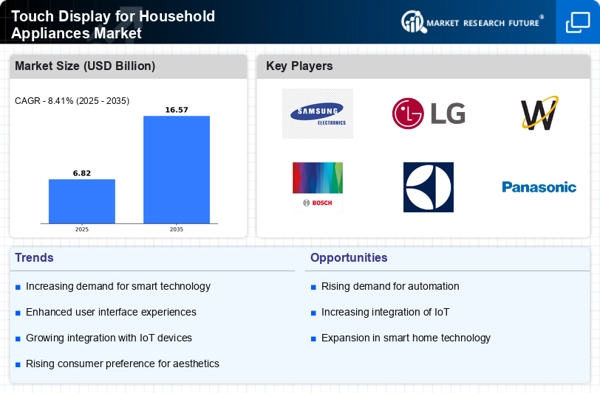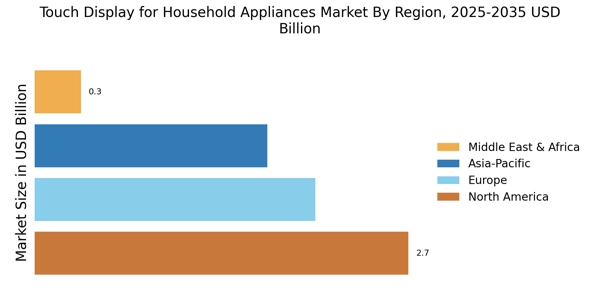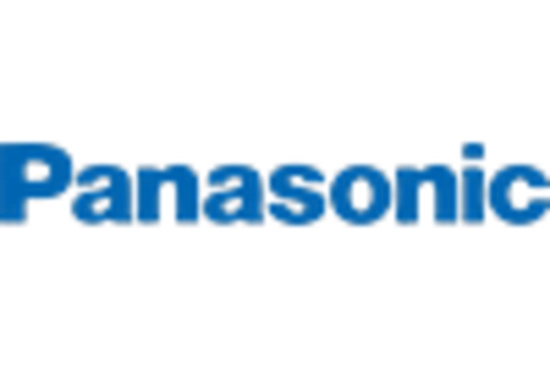User-Centric Design
User-centric design is becoming a pivotal factor in the Touch Display for Household Appliances Market. As manufacturers prioritize consumer preferences, the demand for intuitive and aesthetically pleasing interfaces is on the rise. Touch displays allow for a more engaging user experience, enabling easy navigation and control of household appliances. Data suggests that appliances with user-friendly touch interfaces are more likely to be favored by consumers, leading to increased sales. This focus on design not only enhances functionality but also aligns with contemporary lifestyle trends, where aesthetics and usability are paramount. Consequently, manufacturers are investing in research and development to create touch displays that cater to diverse user needs, further driving market growth.
Rising Consumer Expectations
Rising consumer expectations are a significant driver in the Touch Display for Household Appliances Market. As technology evolves, consumers increasingly demand appliances that offer advanced features and seamless integration into their daily lives. Touch displays provide a modern solution that meets these expectations by offering intuitive controls and enhanced interactivity. Market data reveals that consumers are willing to invest in appliances that provide a superior user experience, which includes the convenience of touch interfaces. This shift in consumer behavior indicates a growing preference for appliances that not only perform well but also offer innovative features. Consequently, manufacturers are compelled to innovate and enhance their product offerings, further propelling the growth of the touch display market.
Integration of Smart Technology
The integration of smart technology into household appliances is a primary driver for the Touch Display for Household Appliances Market. As consumers increasingly seek convenience and connectivity, appliances equipped with touch displays offer enhanced functionality. These displays facilitate seamless interaction with smart home ecosystems, allowing users to control multiple devices from a single interface. According to recent data, the market for smart home devices is projected to grow significantly, with touch displays playing a crucial role in this expansion. The ability to customize settings and receive real-time updates through touch interfaces enhances user experience, making these appliances more appealing. This trend indicates a shift towards more intelligent and responsive household solutions, positioning touch displays as essential components in modern appliances.
Advancements in Display Technology
Advancements in display technology are significantly impacting the Touch Display for Household Appliances Market. Innovations such as improved touch sensitivity, higher resolution, and enhanced durability are making touch displays more appealing to consumers. These technological improvements not only enhance the user experience but also increase the longevity of appliances. As manufacturers adopt cutting-edge display technologies, the market is expected to witness a surge in demand for appliances featuring advanced touch interfaces. Data indicates that the adoption of high-definition touch displays is likely to grow, as consumers seek appliances that offer both functionality and visual appeal. This trend suggests that ongoing advancements in display technology will continue to drive market growth.
Sustainability and Energy Efficiency
Sustainability and energy efficiency are increasingly influencing the Touch Display for Household Appliances Market. Consumers are becoming more environmentally conscious, prompting manufacturers to develop appliances that minimize energy consumption. Touch displays can contribute to this goal by providing users with real-time feedback on energy usage, allowing for more informed decisions. The market is witnessing a rise in demand for energy-efficient appliances, with touch displays serving as a key feature that enhances user engagement. Reports indicate that appliances with energy-saving capabilities are likely to see higher adoption rates, as consumers prioritize sustainability in their purchasing decisions. This trend underscores the importance of integrating touch technology with energy-efficient designs to meet evolving consumer expectations.

















Leave a Comment